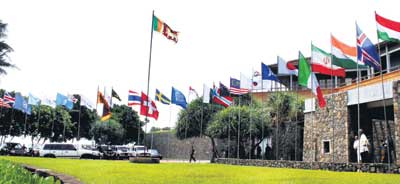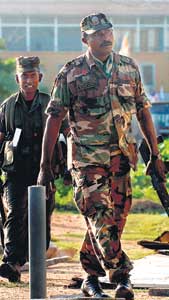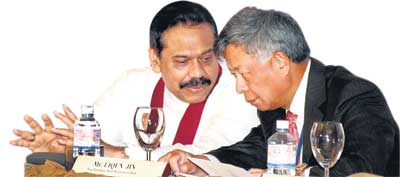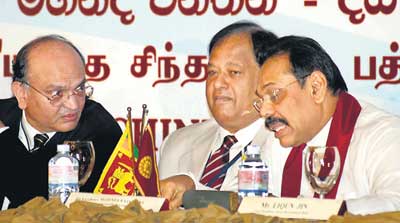| Donors caution
over conflict
Development Forum 2007
 |
| Venue of the Forum- The Lighthouse Hotel, Galle |
The 2007 Development Forum saw the government hierarchy successfully impressing donors with what they called an ‘ambitious but achievable 10 year development plan’ to secure a US$4.5 billion assistance, although donors cautioned that the on going conflict should be at the centre of any discussion to Sri Lanka's future.
They reiterated that the development assistance could be far more effective if the conflict subsided, but said that this is not a precondition to the forthcoming assistance.
 |
| Soldiers patrol the street outside the Lighthouse Hotel during the development forum. |
Frederick Lyon, UN Resident and Humanitarian Co-ordinator refuted the claims that the UN assistance was conditional and achieving rapid rates of growth would necessarily involve peace and conflict resolution. “Our assistance is not conditional. What we are saying is that Sri Lanka could in fact grow economically, socially and all around without the conflict. The country’s available resources can be utilised for that purpose,” he explained. He commended the fact that the country has made significant steps towards achieving millennium goals. “It is important to recognise how Sri Lanka could achieve rapid growth in the coming years and how all communities could benefit from this growth,” Lyon said, reiterating that peace is a prerequisite to achieving this. He forewarned that there needs to be a better definition of how Mahinda Chintana links with the Millennium Development goals, but said that Treasury Secretary, P.B. Jayasundera ended Sri Lanka’s case for development on a positive note. “The Sri Lankan government made excellent presentations to address the issues,” he said.
Echoing his comments, Liqun Jin, Vice President, Operations, Asian Development Bank (ADB) said the donors were impressed by the substance of the discussions and the presentation made by President Rajapaksa.
“The substance of the discussions and the presentations were helpful for the donors to understand the ambitious, but achievable objectives of the government,” he said.
World Bank Vice President for South Asia, Praful Patel said that if progress on peace is made, financing development projects in the country will be much easier.
Peace is the way forward –ADB and Japan
Liqun Jin, Vice President, Operations, Asian Development Bank (ADB) in his opening statement at the 2007 Sri Lanka Development Forum said the conflict has also significant implications for the assistance programmes of the development partners.
 |
| Liqun Jin, Vice President, Operations, ADB |
“Sri Lanka- has tremendous development potential and the economy has proven resilient, so too has the conflict,” he said, adding that the FDI flows have turned out to fall short of expectations. “This is despite Sri Lanka’s liberal trade policies, fairly business friendly environment, and attractive incentives that cost over one percent of GDP in foregone tax revenues per year, or roughly the cost of building the Colombo—Katunayake Expressway,” he noted, adding that several studies have estimated that since the conflict flared up in 1983, it has cut as much as two percent off growth per year. “This means that per capita income could be between 30 to 50 percent higher today, for each and every Sri Lankan, were it not for the conflict,” Jin pointed out, explaining that the rising defence expenditure clearly makes it much harder for the Government to meet the goals in the Fiscal Management Responsibility Act in terms of reducing budget deficits.
He said that Public investment for vital public goods is affected and was concerned that the Jaffna Water Supply Project proposed for ADB support, was put on hold and the pace of tsunami reconstruction in the north and east has also dearly been significantly affected by the resurgent conflict.
“We urge both sides in the conflict to restart meaningful negotiations towards a political solution,” he said, adding that the ADB is greatly encouraged by President Rajapaksa’s intention to come forward with new proposals in the near future.
He also said that the government’s growth targets of eight to 10 percent, while ambitious, are not unachievable and would enable Sri Lanka to not only meet all of its Millennium Development targets — including that halving income poverty —but also set the country well on the road to achieving middle income status.
Commending the Mahinda Chintana Vision and its key elements such as the national infrastructure investment plan and the strong partnership between the public and the private sector to promote economic and social goals and he said that development partners believe that the realisation of the Vision depends on reforms, sound policies and effective implementation.
“The proposed financing from ADB, of US$300 million, is intended to showcase the success of public-private partnership in development projects,” he said.
Reiichiro Takahashi, Deputy Director General of the International Economic cooperation Bureau, Ministry of Foreign Affaires, Japan reiterated that the international community was closely watching how Sri Lanka will move the process forward and build a nation where peaceful co-existence of all the communities including Sinhala, Tamil and Muslim is ensured. |
| |
Patel confirms World Bank’s commitment to helping Lanka’s poor
Praful Patel, World Bank Vice President in his opening statement at the Sri Lanka Development Forum 2007 said the renewed and deepening conflict in Sri Lanka over the past six months or so looms over everything else that might be said.
 |
| President Rajapaksa has a word with Praful Patel, World Bank Vice President while Sarath Amunugama looks on. |
“There is no way to politely skirt this issue. As a major development partner to Sri Lanka, the World Bank would be failing if we did not place the conflict first and centre in our deliberations for it is this that constrains the country's development and stands in the way of its tremendous potential,” he said.
Speaking on the positive side he said the economy grew at about seven percent; the stockmarket reached an all-time high; tourism until the past few months had rebounded to pre-tsunami levels; and over two billion dollars in remittances flowed into the country.
“GDP growth has averaged 5 percent, lifting per capita income to around thirteen hundred dollars and putting Sri Lanka on the threshold of becoming a middle-income country. Because of this growth, the poverty rate in the Western Province has fallen to single-digit levels, demonstrating that growth in Sri Lanka can be pro-poor,” but he noted that the past year has not been good at all for the families of the more than 3,500 Sri Lankans killed as a result of the increased hostilities.
“Nor has it been a good year for the additional over 200,000 persons displaced by the conflict. It has not been a good year for the whole population of the North and East who have gone through serious difficulties and distress. And the tensions among the citizens island-wide have been heightened by recent attacks, some not very far from where we meet today,” Patel said, adding that if inflation continues at the current levels of nearly 20 percent, 2007 will not be a good year for the economy either.
“The government's draft 10-year development framework, the Mahinda Chintana: Vision for a New Sri Lanka- outlines a path for lifting four million mostly rural Sri Lankans out of poverty, while building on the growth that enabled the Western Province to practically eliminate poverty,” he said, adding that The World Bank shares this vision.
“I caution that we cannot spend two days discussing development plans if we do not place the conflict squarely in our sights as the largest obstacle. A development vision cannot exist independently of the conflict. In this regard, we appreciate the government's agreement to discuss the conflict upfront on the first day,” he said.
“Sri Lankan researchers have estimated that the conflict has cost the economy two to three percentage points of GDP growth annually-growth that could have eliminated poverty in the country by now. And, this estimate does not come close to reflecting the human costs of the conflict: more than 65,000 dead, over 500,000 displaced, human rights undermined and a social fabric torn apart by the brutality and persistence of civil conflict,” he noted, adding that if the country can implement the actions needed to realise the Mahinda Chintana and if there is a significant decrease in the hostilities, we can look to a future filled with peace and prosperity for all Sri Lankans.
An important goal is equitable development. This will not be achieved without changes in both the policy and institutional environments. For instance, if policies could shift agriculture towards high-value production and if villages are connected to markets not only through roads but also through business networks, poverty in rural areas can be dramatically reduced.
While commending the Mahinda Chintana for its forward looking initiatives, Patel said that much of the vision-as described in the 10-year development document- would benefit from being made more specific and parts of it will be politically difficult to realise. “If a way forward is not found to translate this vision, there is a grave danger that growth will slow down, inequality will increase and poverty will persist. It is the World Bank's hope that Sri Lanka will find the right path to achieve the envisioned objections and we are committed to help,” he said. Describing the World Bank's more than 50-year relationship with Sri Lanka as being based on trust, mutual understanding and open dialogue, he said that with any long-term relationship, there have been some bumps on the road-or as you say here, "dhoosras" on the cricket pitch.
“No doubt there will be more in the future, but our commitment to remain engaged so that we might find ways to assist Sri Lanka's poor and vulnerable is firm,” he stated, adding that Sri Lanka has demonstrated that it can accelerate growth and achieve high standards of human development. It has also shown that growth can reduce poverty sharply, as for the 5 million people living in the Western Province.
He said that the challenges are daunting and that the World Bank has placed the conflict at the center of any discussion about Sri Lanka's future. “This is not of course a comfortable discussion but development assistance could be far more effective if the conflict subsided,” he added. |
|




